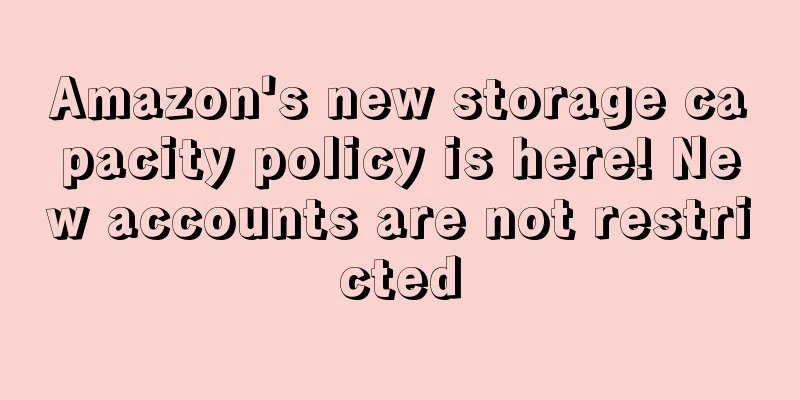Amazon's new storage capacity policy is here! New accounts are not restricted

|
Not long ago, the industry reported that Amazon would make a major adjustment to its storage capacity policy, and some of the stocking restrictions that have constrained sellers for a long time may be lifted. Sellers have been waiting for this policy to be implemented. Before the Spring Festival holiday officially arrived, Amazon finally officially announced the new storage capacity policy.
The new policy mainly includes four important changes, including the cancellation of additional replenishment restrictions and the ability to apply for additional storage capacity. It will be implemented in six sites including the US site from March. What impact will this major reform have on new and old accounts? After the policy is implemented, will it be easier for sellers to stock up or will they face higher costs? Sellers are hotly discussing this.
Amazon's new storage capacity policy has been implemented, with 4 key points
Yesterday, some sellers noticed that Amazon had updated its inventory capacity policy, and today the official announcement was made.
According to official information, Amazon Logistics storage capacity will be officially launched on March 1, 2023 (Pacific Time) . Amazon will only use monthly capacity limits for each storage type, canceling the previous policy of using both weekly replenishment limits and quarterly storage limits. The new policy applies to the US, UK, France, Germany, Italy and Spain .
The changes in the new policy can be summarized into four points:
1. Remove additional replenishment restrictions . Merge replenishment restrictions and storage restrictions, adopt a single Amazon logistics storage quota, and a single limit for each storage type will determine the amount of inventory that sellers can send and store in Amazon's fulfillment centers.
2. IPI assessment will be conducted once a month . The corresponding limit will also be updated once a month, and each limit will be valid for one month.
3. Three-month storage limit forecast . In addition to the confirmed storage capacity for the next month, Amazon will also provide estimated storage capacity for the next two months. In addition, sellers can subdivide storage capacity types by inventory status and storage capacity source (initial capacity or additional capacity requested).
For example, on February 15, Amazon confirmed sellers’ capacity limits from March 1 to 31, reconfirmed or adjusted sellers’ capacity limits from April 1 to 30, and estimated their capacity limits from May 1 to 31.
If your sales and inventory performance exceed platform expectations, the estimated capacity limit may increase, but if your capacity demand is higher than expected, the estimated capacity limit may decrease. Changes in the estimated capacity limit will be reported in the Capacity Monitor.
4. Apply for additional storage capacity . When storage capacity is insufficient, sellers can apply for additional storage capacity through the storage limit manager. Sellers can submit up to 5 applications per month.
This is basically consistent with the information in the new policy documents that have been leaked before: the replenishment quantity limit is cancelled, sellers can apply for storage capacity with a fee, and the IPI assessment is changed to once a month.
The comparison of FBA replenishment and storage restrictions around March 1 is as follows:
For each storage type, sellers will receive a capacity limit every month. In this regard, the new policy is indeed very friendly to new accounts.
New professional sales accounts that have used FBA for less than 39 weeks will not be subject to the capacity limit of Amazon Logistics , and sellers can establish Amazon Logistics sales records without any restrictions. The platform will use this record to determine the storage needs of sellers based on their business growth.
However, old accounts that have used FBA for more than 39 weeks will be subject to Amazon's capacity restrictions. This restriction standard is calculated based on the inventory performance index score and sales performance. Sellers with higher scores will have higher capacity, which includes inventory in stock and inventory in transit.
Additionally, the capacity limit for individual sales accounts remains unchanged at 15 cubic feet.
Paying for storage capacity has become a reality, and sellers are spending more
In addition to the changes in quantity and storage limits, sellers are also concerned about how to pay for capacity expansion in the new policy, and Amazon has also made a special explanation of this part.
If the seller wants to increase the storage capacity of the goods, he can use the capacity manager to request to increase the limited storage capacity, but he needs to set a reservation fee. The specific operation method is as follows:
1. Tell Amazon how much capacity you want to increase and when. For any future period with capacity limits or projected capacity limits, sellers can request a limit increase on a monthly basis. The maximum increase you can request is 20% of the initial capacity limit or 2,000 cubic feet, whichever is greater.
2. Set the maximum reservation fee you are willing to pay for the additional capacity. Because the performance points earned from sales generated by using the additional capacity can be used to offset this fee, sellers do not need to pay upfront.
However, Amazon also reminds sellers that the amount of the reserved fee set here should be based on their own circumstances. For example, whether some of the goods with the increased capacity can be sold smoothly. If you are not sure whether you can sell the inventory and offset the fees, it is recommended that sellers do not request to increase capacity, because the remaining balance (reserved fee minus performance points) will be borne by the seller.
3. Amazon regularly evaluates the capacity of the fulfillment centers (usually twice a week) and approves requests when capacity is available. Amazon will first approve the requests with the highest bid per cubic foot reservation fee, and then proceed in order from high to low until all capacity is allocated.
Amazon has a minimum reservation fee guarantee for reservation fees: Amazon will charge the same reservation fee per cubic foot to other sellers whose applications are approved in the same week. Therefore, if other sellers who apply later are approved for additional storage space at a lower unit reservation fee, the seller's reservation fee will also be reduced.
4. If the seller's request is approved, the capacity limit will be increased in the "Capacity Monitor". After the specified period begins, the seller will earn $0.15 in performance points for every dollar sold using the additional capacity. The platform sets this point to give sellers the opportunity to offset the entire reservation fee, but only if the seller can sell the inventory.
After the new policy is implemented, how should sellers optimize storage capacity and inventory management? Amazon has given several suggestions: cancel shipments that are not intended to be warehoused, increase the sales rate of Amazon logistics inventory, and follow the platform's replenishment suggestions to ensure that the inventory sent does not exceed the recommended quantity.
Sellers have a strong reaction to this new policy. " It means there will be no limit on the number of items shipped, but there will be a limit on volume , and you can pay to increase the volume . Amazon will really make money, " said a seller.
Next, sellers need to ensure healthy inventory turnover and keep their accounts healthy, otherwise they will inevitably have to pay for additional storage capacity. One seller said, "Get your wallet ready to pay for the additional storage capacity."
In addition, yesterday ( January 17), changes to FBA delivery fees, removal and disposal order fees, small and light commodity program fees, and dangerous goods delivery fees took effect at the same time. Coupled with the fees that may be paid for capacity, sellers will face cost increases in many aspects. The business plan for 2023 still needs to be carefully calculated. Amazon |
Recommend
What is BankClarity? BankClarity Review, Features
BankClarity partners with Moneycorp to offer glob...
Cross-border e-commerce has a "lively start" in preparing for the Spring Festival, with the number of New Year gift boxes entering Cainiao's overseas warehouses increasing by nearly 30 times
As the Chinese New Year approaches, products with...
Wildberries fashion category sales exceeded 336 billion rubles in 2021
According to foreign media reports, by the end of...
Shopify added approximately 2.6 million stores, an increase of 200%
Since the outbreak of the epidemic, offline consu...
Successful turnaround! The seller made 160 million yuan in three months
It’s time for the big sellers to announce their p...
What is Dongyi Cross-border ERP? Dongyi Cross-border ERP Review, Features
Dongyi Cross-border ERP is committed to solving sa...
What is RockDove? RockDove Review, Features
RockDove is the flagship brand of Lace & Lawn...
Here comes a large number of service providers that help sellers delete negative reviews and restore accounts
For millions of Amazon sellers, the biggest worry...
Sales surged 40%! Korean high-priced kitchen supplies are now in high demand
Due to the impact of the epidemic , most Korean p...
What is Wanbang Express? Wanbang Express Review, Features
Wanbang Express (Ningbo Wanbang Express Co., Ltd.)...
What is Banggood Easy Online Shopping? Banggood Easy Online Shopping Review, Features
Banggood Easy Online Shopping is an online shoppi...
Tmall and Taobao launched the "Cross-border Worry-free Hosting" service to increase support for domestic merchants to go overseas
Starting from Double 11 this year, Tmall and Taob...
The most popular items that mothers will love in 2022 are announced, and 58% will buy beauty products
Although the peak season has passed, online retai...
What is Quora? Quora Review, Features
Quora is an online question-and-answer website th...
What is TOSAN ERP? TOSAN ERP Review, Features
TosanErp is a free e-commerce ERP that serves more...









